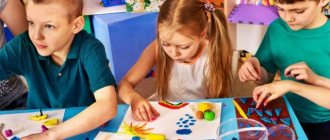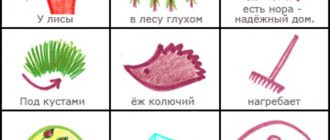In our time of technical breakthrough, a key place is given to the development of human creative abilities. Executive work is transferred to machines and automatic machines, the role of the author belongs to a person of the 21st century - a person with a rich imagination who knows how to find non-standard solutions. The formation of creative abilities begins in childhood, in preschool age. Therefore, diagnosing the imagination of a preschooler occupies a separate place in the education and development program in kindergarten.
Imagination is one of the most important mental processes. It is the basis of figurative thinking, with the help of which a person can create a situation in his mind that is impossible or difficult to reproduce in practice. It becomes possible to solve non-standard problems, as new ideas are born based on previous experience. Imagination also trains thinking and memory, thereby developing creative abilities.
The development of imagination is most effective in children with an unformed psyche, that is, in preschool age. Many techniques have been developed for this. The most effective of them are based on creativity and solving non-standard problems. Since children are a specific category for psychologists to work with, trainings are usually conducted in a form of play that is familiar and understandable to every child.
Game trainings are usually conducted in small groups (6-10 people) three to four times a week under the guidance of a psychologist. The main conditions for successful training are an informal atmosphere, constant communication between children, a comfortable atmosphere in the team, the use of well-known material and the exchange of results and techniques of imagination. During one lesson, three or four games are usually played, both familiar and new.
Here are examples of some game training methods aimed at developing imagination:
- Making a wish for an object using a couple of other objects.
A well-known object (living creature, natural phenomenon), for example “snake,” is called. It is necessary to name two other objects similar to it in terms of characteristics, the combination of which would, if possible, unambiguously define it, i.e. encrypt it using other items. In this case, the following “encodings” can be given as an example: “mountain path” and “leather wallet” (based on the presence of certain features: elongation, tortuosity of the mountain road and the material of the wallet, which together characterize the mysterious object) or “stream” and “mouse” (narrow, twisting and living, mobile), and so on. Within a short period of time (5-7 minutes) you need to find the largest number of options for such encryption and select the best one. The options proposed by the participants are discussed and justified within the group. Based on the results of the game and discussions, the winner is determined, as well as the most accurate and original answer that can be created by the whole group.
This game trains the ability to quickly find the characteristic features of an object and identify other objects that have both similar and different features, keeping several objects in memory at once. This is the basis of combination - one of the main techniques of imagination.
— Guessing an item based on a couple of other items.
This game is a mirror image of the previous one. The leader (and later the players) names two objects that, in his opinion, unambiguously indicate some third object he has chosen. For example, having thought of the word “fountain,” say two words: “tree” and “rain,” asking the players to determine which word was intended. The players’ task is to write as many variants of objects or phenomena as possible that decipher a given pair of words, i.e. having the sum of various properties and attributes of these objects (for our example, this could be a river delta: water branches out like a tree; sawdust falling to the ground, etc.). The winner is the player who, in addition to the intended item, names the largest number of other items, especially unusual ones, and explains the given answers.
This game develops the ability to quickly operate with characteristic features of objects: highlight, compare, summarize, form combinations and create a whole picture from individual features.
— Search for associations.
The basis is a phrase or phrase, for example: “The plane is taking off - fasten your seat belts.” It is necessary, in a limited amount of time, to write in a column the largest number of associations that the phrase evokes. There are both banal associations (“pilot”, “stewardess”, “car seat belts”), and unusual ones (“before starting any business, make sure you’re on the safe side”; “a bird in flight doesn’t have anything fastened on”), but they should be closely are related in meaning to the original phrase (too abstract or personal associations, for example, such as: “My neighbor, flight mechanic Petrov, has a black mustache” are not taken into account). The player with the largest number of unique and non-standard associations wins.
This game develops associative thinking - the foundation of imagination.
— Transfer of associations along the chain.
You need to form a chain of players. The presenter gives the player first in the chain a strip of paper with an initial phrase, for example: “During a thunderstorm, you should close the window.” He must quickly write one of his associations on the next strip and pass it to the next, second player, who writes another association on a new strip and passes it to the third player, and so on. The result is, for example, the following associative chain: “Ball lightning that flew through the window. - Fire in the house. — Zero one (fire department telephone number, which can be understood as the score of a football match). — Spartak (football team, but can be perceived as a historical character),” etc.
When discussing the results of the game, the participants analyze and study the resulting associative chain, proposing in each case alternative and original associations that could lead to a completely different final result.
The described set of games trains both the imagination and other mental processes associated with it, allows you to teach children to think outside the box and quickly solve problems that they have not encountered before.







